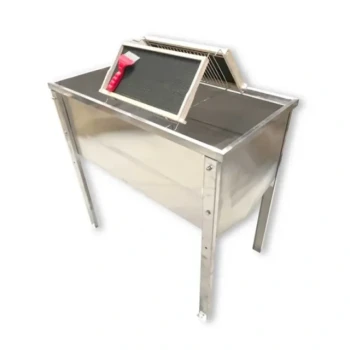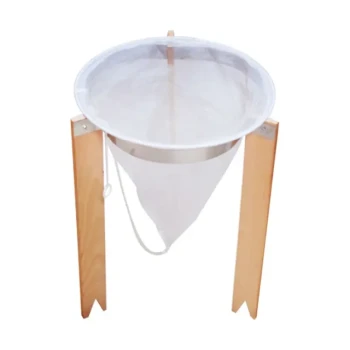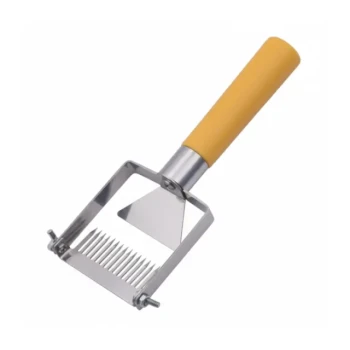The core efficiency benefit of using a honey heating tank is its ability to dramatically accelerate the entire processing workflow, from extraction to bottling. By gently warming the honey, the tank reduces its viscosity, making it flow more easily and speeding up subsequent steps like filtration and packaging.
A honey heating tank is not just a heater; it is a central processing tool. Its primary function is to control honey's fluidity, which in turn unlocks significant efficiency gains across your entire operation while simultaneously protecting the final product's quality.

How Controlled Heat Transforms Your Workflow
The efficiency of a honey heating tank stems from one simple physical principle: warm honey flows much more easily than cold, viscous honey. This change in fluidity has cascading benefits throughout your production line.
The Core Principle: Enhancing Fluidity
The primary function of the tank is to gently heat honey to a target temperature. This reduces its thickness, or viscosity, making it far easier to pump, filter, and handle without the resistance encountered with raw, cool honey.
Accelerating Filtration and Clarification
One of the most time-consuming steps in honey processing is filtration. Warmed, fluid honey passes through filters much more smoothly and quickly, allowing for the effective removal of impurities like wax particles and other hive debris. This results in a clearer final product with less processing time.
Streamlining the Bottling Process
Thick, viscous honey is slow and difficult to bottle accurately. By using a heating tank, the honey becomes fluid enough for rapid and consistent bottling, reducing labor, minimizing spills, and ensuring uniform fill levels in every jar.
Enabling Continuous Operation
Many commercial-grade heating tanks are designed for a continuous workflow. This allows honey to be steadily fed into the system, heated, and moved to the next stage, eliminating the start-and-stop nature of batch processing and maximizing throughput for larger operations.
Beyond Speed: Preserving Quality and Value
True efficiency isn't just about speed; it's about producing a high-quality, valuable product with minimal waste. A proper heating tank is engineered to enhance efficiency while safeguarding the honey's natural properties.
The Importance of Gentle, Controlled Heat
The key is precise temperature control. A good tank provides gentle, uniform heat that avoids hot spots. This preserves the delicate enzymes, aromas, and flavors of the honey, preventing the degradation that can occur with crude or uncontrolled heating methods.
Achieving a More Marketable Product
The improved filtration enabled by warming the honey leads to a final product that is clearer and more visually appealing to consumers. This enhanced clarity can directly translate to higher perceived value and marketability.
Understanding the Trade-offs
While highly beneficial, a honey heating tank is a professional tool with operational considerations that require careful management.
The Risk of Overheating
The single biggest risk is improper use. Setting the temperature too high or heating the honey for too long can be destructive. This can degrade beneficial enzymes and increase HMF (hydroxymethylfurfural) levels, which damages the honey's quality and flavor profile.
Initial Investment and Energy Costs
These tanks represent a significant capital investment. You must also account for the ongoing energy costs required to operate the heating elements. The return on this investment depends entirely on the scale of your operation and the time saved.
Hygiene and Maintenance
Like any food processing equipment, heating tanks require diligent cleaning to maintain hygiene. Honey is sticky, and any residue can become a source of contamination if not properly managed between batches.
Making the Right Choice for Your Operation
Integrating a honey heating tank is a strategic decision that should align with your specific production goals.
- If your primary focus is maximizing throughput for a commercial operation: A heating tank is an essential investment to accelerate filtration and bottling, enabling a continuous and efficient workflow.
- If your primary focus is preserving the artisanal quality of unique honey varietals: A tank with highly precise, low-temperature control is critical for gently liquefying crystallized honey without damaging its delicate enzymes and flavor.
- If you are a small-scale hobbyist with manageable volumes: Carefully weigh the cost against the time saved, as slower, gentle warming methods may be sufficient for your processing needs without the capital expense.
Ultimately, a honey heating tank empowers you to take direct control over one of the most critical variables in honey processing.
Summary Table:
| Efficiency Benefit | Key Outcome |
|---|---|
| Reduces Viscosity | Faster pumping, filtration, and handling |
| Accelerates Filtration | Quicker removal of wax and debris; clearer honey |
| Streamlines Bottling | Consistent fill levels, reduced labor and spills |
| Enables Continuous Operation | Maximizes throughput for commercial apiaries |
| Preserves Quality | Gentle, controlled heat protects enzymes and flavor |
Ready to optimize your honey processing workflow?
As a leading supplier to commercial apiaries and beekeeping equipment distributors, HONESTBEE provides the high-quality honey heating tanks and supplies you need to achieve these efficiency gains. Our equipment is designed for durability and precise temperature control, helping you scale your operation while protecting your product's value.
Contact our wholesale experts today to discuss the right heating solution for your business and see how we can support your growth.
Visual Guide

Related Products
- Stainless Steel Heated Honey Tank Warming Heating Tank
- Professional Honey Storage Tank with Agitation System
- Stainless Steel Uncapping Tank with Stand and Strainer
- Stainless Steel Honey Storage and Settling Tank with Double Strainer
- 0.5T Capacity Honey Dehumidifier Dryer with Vacuum Heating and Thickening Filtering Machine
People Also Ask
- What is the purpose of the double-walled stainless steel tank in the honey mixer? Gentle, Even Heat for Quality Honey
- Can I store honey in stainless steel? A Guide to Safe, Long-Term Honey Storage
- What is the primary function of a honey heating tank? Master Your Honey Processing with Precision Control
- What safety and maintenance tips should be followed when using a honey bucket heater? Ensure Honey Quality and Equipment Longevity
- What are the overall benefits of using a honey heating tank in honey processing? Ensure Quality & Boost Efficiency



















